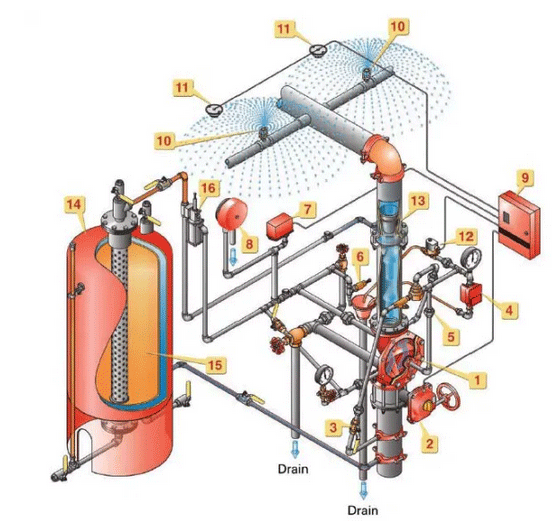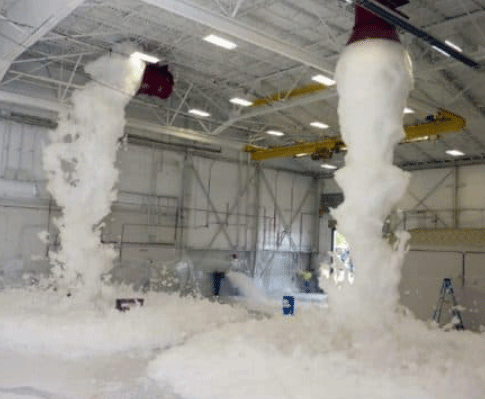Diagram of working principle of foam fire extinguishing system
A foam fire suppression system is a type of wet sprinkler system that combines both water and a foaming agent for large-scale fire suppression. This foam sprinkler fire suppression system can put out large-scale fires in seconds with amazing efficiency.
To clearly understand the operating principle diagram of the foam fire extinguishing system, you need to pay attention to a few of the following principles:
What is foam firefighting foam?
“ “Fire extinguishing foam” in a foam fire extinguishing system is a fire extinguishing agent that extinguishes flammable or combustible liquids by cooling and separating the source of ignition from the surface. Foam suppresses and extinguishes fire and vapors alike. It can also prevent reactivation. It is also known as “firefighting foam”. This foaming agent is made up of small bubbles filled with air, which has a density less than water. Foam is made up of water, foam concentrate and air. Different manufacturers have their own foam solutions and concentrates. The ratio of foam to water depends on the application.
How does a foam fire suppression system extinguish a fire?

How does the fire suppression system discharge foam?
Foam fire suppression systems are designed like a conventional sprinkler system in that the stored water flows through a system of pipes, then it is discharged through sprinkler heads. However, the main difference with foam spray systems and other traditional wet sprinkler systems is the addition of a foaming agent. The foaming agent is stored separately from the water and the two substances are mixed in the piping system before discharge (also known as a foam mixer). At the end of the pipe are nozzles. Foaming agents are added or pushed into the water at the last moment before rinsing. When water mixes with the foaming agent, expansion occurs and creates a covering layer of foam to fill large areas.

What are the common uses/applications for foam systems?
Normally, when we understand the diagram of the operating principle of the foam fire extinguishing system, you will see that these fire extinguishing systems have the advantage of being able to extinguish fires in large areas where there is a lot of liquid. flammable or flammable. For example, some common uses include: - Airplane hangar - Storehouse - Marine applications
- Processing area
- Flammable liquid storage
- Jet engine testing facility
The reason this type of system is most commonly used in these applications is due to foam's universal ability to not only extinguish, but extinguish a fire in a way that prevents re-ignition.
How many main types of foam are there?
There are three main types of foaming agents available today that have different properties such as expansion rates. These types include low, medium and high expansion systems. The expansion ratio is the volume of finished foam divided by the volume of foam solution used to create the finished foam.
- For example, a 5 to 1 ratio means that one gallon of foam solution after aeration will fill a 5-gallon container with expanded foam concentrate. Low expansion foam has the lowest viscosity, or thickness/dense, and expands at a ratio of 2 to 1 and 20 to 1. Medium expansion foam expands at a ratio of 20 to 1 and 200 to 1. Expansion foam High expansion has an expansion ratio of over 200 to 1. All foams can quickly cover large areas, but at different rates and densities. Therefore, low-expansion foams typically provide an individual level of protection based on the needs of the facility the system is set up to protect.
There are quite a few benefits to foam fire suppression systems. These systems are quite effective and efficient when used properly. Foam systems have a very small negative impact on the environment. Foaming agents readily biodegrade in natural environments and wastewater treatment facilities. Foam fire suppression systems can cover larger areas, filling a giant warehouse for example, in just a few seconds. These systems are ideal if you need a fire extinguishing agent that pours and expands to cover a large area quickly. Ultimately, foam fire suppression systems are often more cost-effective from both an installation and maintenance standpoint.
What precautions should be taken before choosing this system?
As beneficial and effective as foam fire suppression systems are, there are some things to consider. Foam systems require a lot of water. This means access to widespread water supplies is needed. The cleaning process after the foam prevention system discharges can be quite a job. Foam needs to be contained and kept in a clean, cool place. Finally, like traditional sugar systems, foam systems are also susceptible to freezing in subzero cold weather.
There are several types of foam fire suppression systems
Foam fire suppression systems are usually divided into the following four (4) types:
- Wet pipe system
- Dry pipe system
- Flood discharge system
- Preaction system
How many types of firefighting foam are there today?
There are different types of foam concentrates, suitable to the application being considered. Typical types of foam concentrates are as follows:
- Aqueous film forming concentrate (AFFF).
- Film Forming Fluoroprotein Foaming Concentrate (FFFP).
- Alcohol Resistant Foam Concentrate, used for extinguishing fires on materials that would normally be destructive to conventional AFFF or FFFP foam as well as fires involving hydrocarbons.
- Fluoroprotein Foam Concentrate.
Note: We only use foaming agents from each brand, do not mix different types for use in firefighting. according to the manufacturer's recommendations.
How to design and construct the operating principle diagram of the foam fire suppression system?
- The water supply must be properly designed to supply the system at the design discharge rate and pressure for a minimum of 60 minutes.
- In all cases, the design discharge density shall not be less than 0.16 gpm/ft2 (6.5 mm/m2). Greater densities may be used depending on the type of fire as well as the foam manufacturer's recommendations.
- Taking into account this minimum density, the foam solution shall be designed to discharge for a period of 10 minutes over the entire system area for sprinkler and water foam systems and over the design area (area design area equal to 465 square meters in accordance with Paragraph 7.3.7.1 of NFPA 16) for wet pipe, dry pipe and pre-foam water systems. In case the discharge density is higher than the minimum specified [0.16 gpm/ft2 (6.5 mm/m2)], it is permissible to greatly reduce the foam discharge time, but in no case should the time be less than more than 7 minutes.
- Whenever occupancy standards specify a design area other than 465 square meters, occupancy standards shall prevail.
- Sprinkler spacing shall not exceed 100 square feet (9.3 square meters) per sprinkler or exceed 12 ft (3.7 m) spacing between sprinklers installed at street level. branches or between branch lines.
- Whenever sprinklers are installed on the roof or ceiling, their temperature rating should be in the range of 121 degrees Celsius to 149 degrees Celsius. Whenever installed at a lower level , their temperature rating will range from 57 degrees Celsius to 77 degrees Celsius.

Have 0 comment, evaluate about Diagram of working principle of foam fire extinguishing system
TVAdministratorsAdministrators
Welcome, honored guests. Please leave a comment, we will respond soon